Everything You Need to Know About Pet Amazon Parrots
Amazon parrots have all the qualities you look for in a BFF: intelligence, friendship, sociability, and playfulness. It's no wonder these colorful parrots have become popular companions for bird lovers.
In fact, Amazon parrots enjoy interacting with their humans and form strong bonds by showing affection through cuddling, singing, and playing games with you.
To learn more about Amazon parrots, we reached out to Veronica Villanueva, DVM, the Medical Director of VEG ER for Pets in Anaheim, California. At her clinic, the staff cares for many types of animals, from parrots and reptiles to small animals, dogs, and cats.
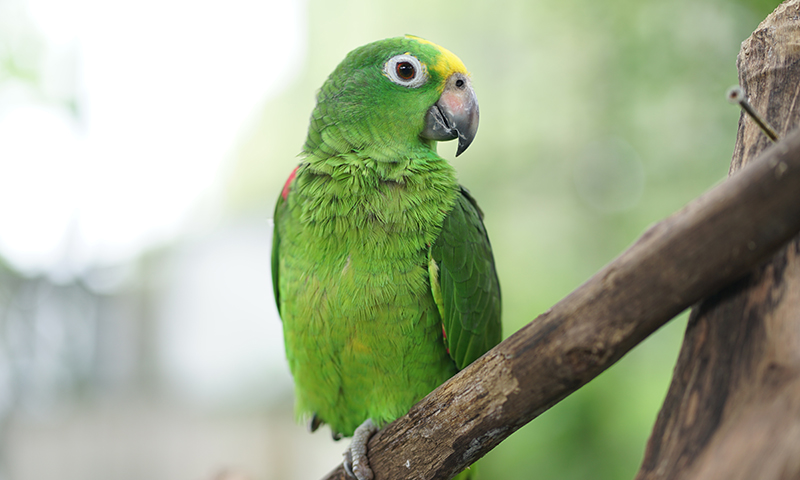
A healthy Yellow-naped (headed) Amazon Parrot should have brightly colored feathers.
What Colors Are Amazon Parrots?
Several species of Amazon parrots originate from Central America, Mexico, South America, and the West Indies, each with its own color patterns.
"The most common types of Amazon parrots, such as the red-crowned Amazon, yellow-naped (or headed) Amazon, or blue-fronted Amazon, have vibrant greens, bright yellows, and blues in their plumage," Villanueva explained. "Their feathers should be shiny and colorful without any dullness, patches, or noticeable bald spots."
She says if you notice an Amazon parrot with faded colored feathers or experiencing feather loss, the bird may have an illness or nutritional deficiencies. Be sure you consult with an avian veterinarian for professional advice and a treatment plan.
What Sounds Do Amazon Parrots Make?
Amazon parrots are known for many vocalizations. As an example, listen to the whistle, bark, and squawk of a red-crowned Amazon parrot on the Cornell Lab Birds of the World website.
In the mornings, your pet might whistle or sing to you! They also enjoy imitating your words, songs they hear, and sounds in their environment, such as microwave beeps or cellphone notification pings. Ohio Pets shares a video on YouTube of a chatty yellow-naped Amazon parrot making a variety of sounds.
If your Amazon parrot makes louder calls or screeches, it might be looking for a mate. These vocalizations indicate courtship behavior. However, if it's more of a high-pitch, shrill cry or squawk, your bird is likely in distress or sounding an alarm and requires immediate attention.
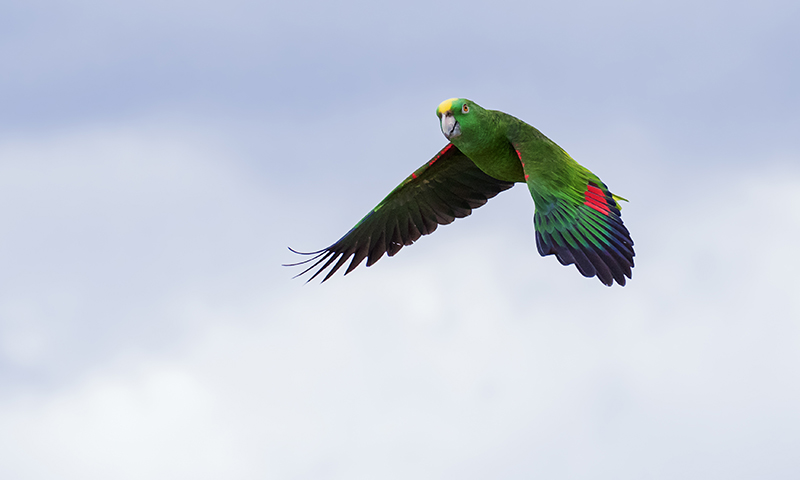
Yellow-headed Amazon parrot in flight.
How Big Do Amazon Parrots Get?
Juvenile Amazon parrots measure approximately 6 to 8 inches and mature into adults at 10 to 18 inches in length, depending on the species. The yellow-naped Amazon is one of the largest varieties.
When it comes to housing a pet Amazon parrot, Villanueva recommends a spacious, large habitat with room for your pet to spread his wings and move around comfortably.
"An appropriate cage should be about 24 inches wide, 24 inches deep, and 36 inches high. The larger the cage, the better, but make sure it's safe and has no toxic materials like lead or zinc," she added.
In addition to a cozy aviary, your pet Amazon needs space to fly. To nurture mental stimulation and physical exercise, allow the pet to fly freely in an open space in your home, such as a living room. For safety, ensure all windows and doors are securely closed to prevent escape.
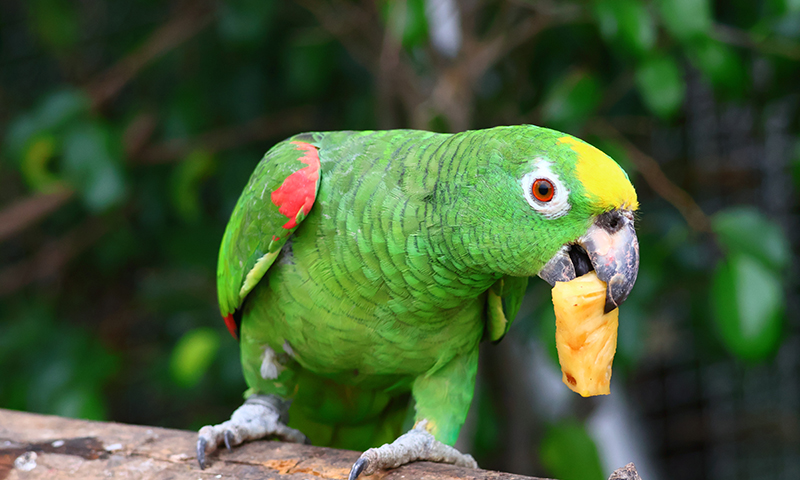
Blue-fronted Amazon parrot eating a piece of pineapple.
What Do I Feed My Amazon Parrot?
When it comes to snacks and meals, your Amazon parrot needs variety.
Pelleted food
Start by offering nutritionally balanced pellet food for up to 60 to 70% of the daily diet, such as Kaytee Exact Rainbow Large Parrot Food. This formula features Omega 3s for brain and heart health, as well as probiotics and prebiotics for digestive wellness. As a bonus, it's less messy than seed mixes that produce seed hull and nutshell waste.
Fruits & vegetables
Then, offer your parrot fresh, raw fruits and vegetables for daily snacks, up to 30 to 40% of the daily food intake. Villanueva recommends apples (seeds removed), bananas, berries, grapes (seeds removed), carrots, sweet potatoes, and leafy greens. As you experiment with which produce your Amazon parrot enjoys most, don't get tempted to share all the goodies in your kitchen. Some foods are toxic to Amazon parrots, including avocados, onions, garlic, alcohol, and caffeinated drinks/foods. And keep dairy products off the menu as parrots experience lactose intolerance.
Nuts & seeds
Finally, your Amazon parrot can occasionally have raw, unsalted nuts and seeds as treats. However, they are high in fat, so don't overdo it! Offer one whole walnut or Brazil nut in the shell for enrichment as a reward for good behavior during playtime or training each day.
Fresh water
Like all birds, Amazon parrots require daily access to fresh, clean water. If your pet hangs out in your home, away from his aviary often, offer a second food and water station in his favorite spot to keep him properly fed and hydrated.
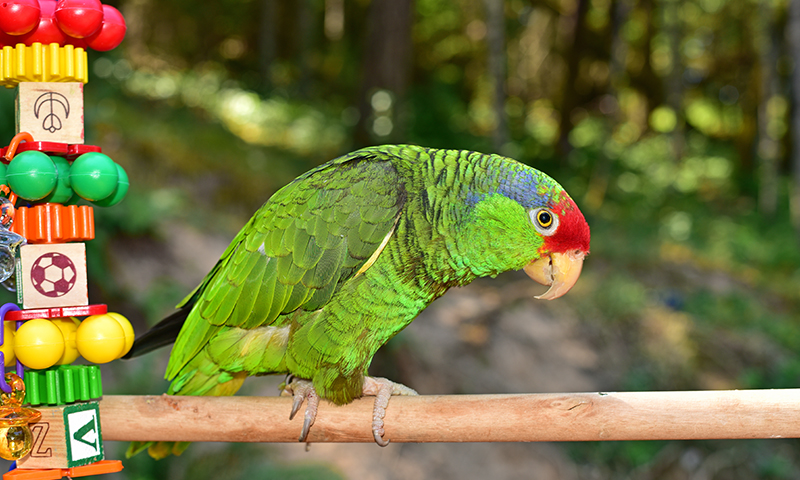
Amazon parrot playing with wooden toys.
Do Amazon Parrots Like Toys?
These colorful, clown-like birds adore toys and will keep both you and themselves entertained when they have a variety of options at their... beak and toenail tips!
Try these four types of toys in your parrot's habitat to encourage mental and physical enrichment:
-
Musical toys: Consider hanging parrot toy bells from the aviary or leaving a radio on in the room where your bird spends most of his time. Some Amazon parrots can learn entire songs!
-
Interactive toys: Amazon parrots embody curiosity and like to look in mirrors and investigate rope toys.
-
Chewing toys: To keep your parrot's beak healthy and filed down, offer toys made from wood blocks, cardboard, and other natural materials such as coconut shells.
-
Foraging toys: Give your Amazon parrot extra mental stimulation by offering a toy with food tucked inside. This engages their problem-solving skills.
You might be tempted to share a cute children's toy with your parrot, but don't! Items made of plastic (potentially covered in toxic paint), with small parts, may get chewed and ingested, causing a visit to the avian veterinarian.
Feeling crafty? Check out DIY Parrot Toys You Can Make at Home.
Note: Avoid using cookware with non-stick coating, candles, air fresheners, or grills that give off smoke or fumes that may be toxic to birds.
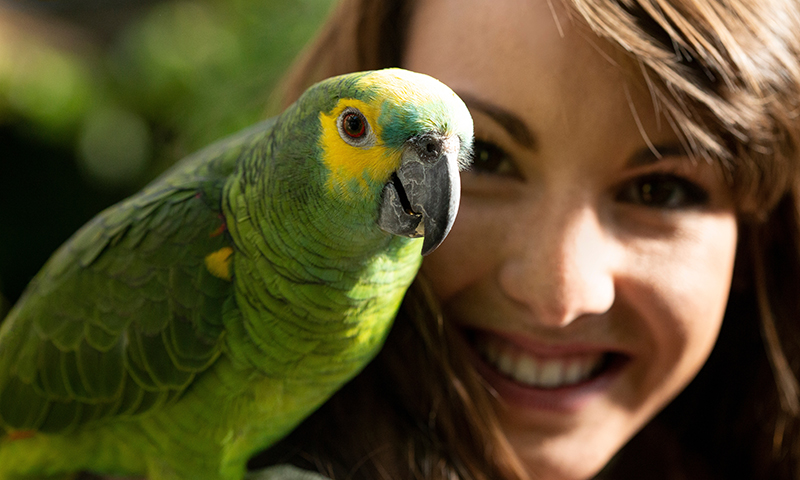
Yellow-crowned Amazon parrot bonding with his owner.
How Can I Bond with My Amazon Parrot?
It's easy to spend time with these big, green, lovable parrots. Amazons have a 40- to 60-year lifespan, so plan to get to know your bird well. And encourage a secondary younger family member or friend to bond with the pet so he can live his entire life with people he loves and cares about.
To build your connection with your Amazon parrot, spend quality time with him daily by playing, talking with him, and working on training him to do bird tricks or solve problems.
"Start socializing them early to get them comfortable with human interaction, but always respect their personal space when needed. Bonding with your Amazon parrot takes time and patience," Villanueva explained.
And when your pet does well, let them know!
"Positive reinforcement works best with Amazon parrots, so be sure to reward them with treats and praise," Villanueva added.
Try Kaytee Granola Bites with Superfoods Spinach & Kale. The round shape is easy for your Amazon to hold with his foot as he nibbles away at the blend of dried fruits, vegetables, grains, and seeds.
When working on bonding, know that Amazon parrots can show moments of independence and not want to get held or sit on your lap. Learn to read your pet's cues for playtime (calling for you, pacing near the habitat door, watching you intently), and alone time (retreating from activity, flying back to their aviary).
Amazon Parrots Can Exhibit Irritating Behaviors
Just like humans, no pet acts perfectly all the time. If you're in the consideration stage, it's essential to know that while Amazon parrots can become wonderful companions, some find their occasional antics annoying.
-
When an Amazon parrot vocalizes, they can become incredibly loud and noisy, especially when mimicking sounds.
-
As a curious bird, you might discover your Amazon parrot becoming extra mischievous by chewing on furniture or other things they shouldn't. (Training helps correct this.)
-
During springtime breeding seasons (starting at ages 3 to 5), Amazon parrots can become territorial and aggressive, which is difficult to manage if you're not familiar with these tendencies.
Amazon Parrots Make Great Pets
Amazon parrots love to play, sing, and socialize. Keep your feathered pet happy by establishing a routine for feeding, playing, bonding, and bedtime. This builds trust over time, creating an unbreakable connection between you and your bird.
In the wild, Amazon parrots form large flocks. This means they enjoy being around other birds — and you — making them a good choice for bird lovers, even if you have more than one feathered friend in the home.
Learn more about avian care in Pet Birds' Eating Behaviors and How To Identify Them and Pet Bird Routine.
